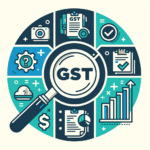The Benefits of Integrating GST Compliance with ERP Systems
For many small business owners in India, managing Goods and Services Tax (GST) can feel like navigating a complex maze. The constant cycle of invoicing, Maintaining Accurate Accounting Records for Tax Purposes, reconciliation, and timely filing is not just time-consuming but also fraught with the risk of errors. While compliance is non-negotiable, modern technology offers a powerful solution to simplify this entire process. By integrating your Enterprise Resource Planning (ERP) system with your GST processes, you can unlock significant GST compliance benefits, transforming a daunting task into a streamlined, automated, and efficient part of your business operations. This integration is no longer a luxury for large corporations; it’s a crucial step for any small business aiming for growth and efficiency in today’s digital economy.
The Challenge: Why GST Compliance is a Hurdle for Indian Businesses
Before we explore the solution, it’s essential to understand the specific challenges that make GST compliance a significant hurdle. An ERP system directly addresses these core pain points, turning weaknesses in your process into strengths.
The Intricacies of GST: CGST, SGST, & IGST
The GST framework in India is designed with different components to cater to transactions within a state and between states. For every intra-state transaction (within the same state), a business must levy both Central GST (CGST) and State GST (SGST). For inter-state transactions (between two different states), Integrated GST (IGST) is applied. Keeping track of the correct tax type and rate for every single sale and purchase, depending on the location of the buyer and seller, adds a layer of complexity that can be difficult to manage manually, especially as transaction volumes grow.
The Risks of Manual Data Entry
When your accounting relies on spreadsheets and manual data entry, the risk of human error skyrockets. A simple typo in a GSTIN, an incorrect invoice number, applying an old GST rate, or a minor calculation mistake can have major consequences. These errors can lead to incorrect GST filings, which may result in show-cause notices from the tax department, interest on delayed payments, and hefty penalties. These financial repercussions can strain a small business’s cash flow and create unnecessary legal stress.
The Tedious Task of Reconciliation
One of the most critical and time-consuming aspects of monthly GST compliance is reconciliation. To claim the full Input Tax Credit (ITC) you are entitled to, you must painstakingly match the purchase invoices in your books with the data reported by your suppliers in their GSTR-1, which appears in your GSTR-2B statement. Manually comparing hundreds of invoices line by line is not only a tedious chore but also highly susceptible to errors and omissions, leading to potential loss of valuable ITC.
The Solution: How GST and ERP Integration India Works
Understanding the challenges makes the value of the solution crystal clear. Integrating your GST compliance process with an ERP system provides a centralized, automated, and accurate way to manage your tax obligations.
What is an ERP System? A Quick Overview
Think of an Enterprise Resource Planning (ERP) system as the central nervous system of your business. It’s a single software platform that integrates and manages all your core business functions in one place. This includes everything from accounting and finance to sales, purchasing, inventory management, and customer relationship management. Instead of having separate, disconnected software or spreadsheets for each function, an ERP provides a single source of truth for all your business data.
How Integration Helps Streamline GST in ERP
The magic of GST and ERP integration India lies in its ability to bridge your daily operations with your compliance needs seamlessly. When you create a sales invoice or record a purchase in your ERP, the system automatically captures all the necessary details—customer/vendor GSTIN, HSN/SAC codes, place of supply, and item value. Based on pre-configured rules, it instantly applies the correct GST rate (CGST + SGST or IGST) and records the transaction in a structured, error-free format. This automation ensures that the data required for your GST returns is being accurately compiled in the background with every transaction, making the process of integrating ERP systems India a game-changer for compliance.
Top 5 GST Compliance Benefits of Using an ERP System
Integrating an ERP system isn’t just about convenience; it offers tangible advantages that directly impact your bottom line and operational efficiency. Here are the top five benefits.
1. Automated and Accurate Tax Calculations
One of the most significant advantages of ERP with GST is the elimination of manual tax calculations. An ERP system can be configured with the latest GST rates linked to specific HSN (for goods) or SAC (for services) codes. When you create an invoice, the system automatically identifies the product or service, pulls the correct HSN/SAC code, and applies the corresponding tax rate. It also intelligently determines whether to apply CGST/SGST or IGST based on the “place of supply” rules. This removes guesswork and ensures every single invoice is 100% accurate, minimizing the risk of over-charging or under-charging tax.
2. Simplified and Compliant Invoicing
Generating a GST-compliant invoice involves more than just adding tax. It requires specific mandatory fields like your GSTIN, the customer’s GSTIN, a unique invoice number, HSN codes, and a clear breakdown of taxes. ERP systems are designed to generate professional, compliant invoices with all these fields automatically populated, a process detailed further in our Understanding GST Invoicing: A Detailed Guide. Furthermore, with e-invoicing becoming mandatory for more businesses in India, modern ERPs can integrate directly with the government’s Invoice Registration Portal (IRP) to generate an Invoice Reference Number (IRN) and QR code in real-time, ensuring you meet your legal obligations effortlessly.
3. Real-Time Data for Effortless Reconciliation
The positive impact of ERP on GST compliance is most evident during the reconciliation process. Because all your sales and purchase data is centralized and updated in real-time, matching your records against the GSTR-2B statement becomes incredibly simple. Most ERPs offer built-in reconciliation tools that can import your GSTR-2B and automatically flag any discrepancies between your purchase records and your suppliers’ filings. This allows you to follow up on missing invoices promptly and ensure you claim every rupee of eligible Input Tax Credit (ITC) you are entitled to.
4. Seamless Preparation for GST Return Filing
For most businesses using ERP for GST compliance, the days of manually compiling data from dozens of spreadsheets for monthly and quarterly returns are over. An integrated ERP system can auto-populate the data needed for your GSTR-1 (details of outward supplies) and GSTR-3B (a summary return) reports with just a few clicks. The system pulls all the verified, reconciled data from your sales and purchase ledgers and organizes it in the format required by the GST portal. This drastically reduces the time, effort, and stress associated with return filing, a process you can learn more about in our guide on How to File GST Returns Online: A Step-by-Step Guide of the GST Filing Process & Procedure.
5. A Centralized Audit Trail
In the event of scrutiny or an audit from the tax department, having a clean, organized, and easily accessible record of all your transactions is crucial. An ERP system provides exactly that. Every invoice, payment, and journal entry is recorded chronologically in a single, secure system, creating a robust audit trail. If an official asks for details about a specific transaction from months or even years ago, you can retrieve the complete record in seconds, demonstrating transparency and making the audit process significantly smoother and less stressful.
Choosing the Right ERP Solutions for GST Compliance in India
Selecting the right ERP is critical to unlocking these benefits. Not all systems are created equal, and it’s important to choose one that is specifically designed for the Indian regulatory landscape.
Key Features to Look For in a GST-Ready ERP
When evaluating different options, ensure the software includes the following features:
- Automated GST calculations: The ability to handle CGST, SGST, IGST, and cess automatically.
- E-invoicing and E-way bill generation: Direct integration with government portals for seamless compliance.
- Advanced ITC reconciliation tools: A feature to import GSTR-2B and perform automated matching.
- Automatic generation of GST reports: The ability to create data for GSTR-1, GSTR-3B, and other reports easily.
- Cloud-based accessibility: Allows you to manage your business finances from anywhere, at any time.
- Scalability: The system should be able to grow with your business, handling increasing transaction volumes.
It’s More Than Just Software
Implementing an ERP is a significant step, but technology is only part of the equation. Ensuring the system is configured correctly, your master data (like HSN codes) is accurate, and your tax filings are reviewed by a professional is key to foolproof compliance. This is where TaxRobo comes in. We not only manage your GST filings with precision but can also provide expert guidance on selecting and implementing the best accounting and ERP solutions for GST compliance in India tailored to your unique business needs.
Conclusion
The complexities of manual GST management—from intricate calculations to tedious reconciliations—can stifle a small business’s growth. By integrating GST compliance with a robust ERP system, you can solve these challenges through powerful automation, enhanced accuracy, and streamlined efficiency. Investing in this integration offers immense long-term GST compliance benefits. It minimizes your financial risk, saves countless hours of administrative work, and, most importantly, frees you and your team to focus on what you do best: growing your business.
Ready to make your GST compliance effortless? Contact the experts at TaxRobo today for a free consultation. Let us help you streamline your finances and ensure you are 100% compliant.
Frequently Asked Questions (FAQs)
1. What is the biggest benefit of GST and ERP integration in India?
The single biggest benefit is the automation of data entry and tax calculations. This dramatically reduces the risk of human error, which is a leading cause of incorrect filings, mismatched ITC, and potential notices or penalties from the tax authorities. It shifts compliance from a manual, error-prone task to an automated, reliable process.
2. Are ERP solutions for GST compliance expensive for a small business?
Not anymore. While traditional, on-premise ERP systems were historically expensive, the rise of cloud computing has made powerful solutions accessible and affordable for small businesses. Many scalable, subscription-based accounting and ERP platforms (like Zoho, Tally Prime on Cloud, and QuickBooks) are designed with SMEs in mind. The cost savings from avoiding penalties, maximizing ITC, and saving valuable time often provide a very quick return on this investment.
3. Does an ERP system file my GST returns for me?
An ERP system does most of the heavy lifting by preparing and structuring all the data needed for your returns (like GSTR-1 and GSTR-3B) with high accuracy. While some advanced systems offer direct filing capabilities through APIs, it is always highly recommended to have a tax professional review the system-generated data before it is submitted to the official GST Portal. This ensures a final check for any anomalies and guarantees complete compliance.
4. How exactly does an ERP help with claiming Input Tax Credit (ITC)?
An ERP system simplifies ITC reconciliation immensely. It allows you to import your GSTR-2B statement (which contains the sales data uploaded by your suppliers) directly from the GST portal. The system can then automatically compare this official data against the purchase invoices you have recorded. It will instantly highlight any discrepancies, such as mismatched invoice numbers, different taxable values, or invoices that your supplier has not yet uploaded. This allows you to proactively contact your suppliers to correct errors, ensuring you can claim the full ITC you are legally entitled to without manual effort.



